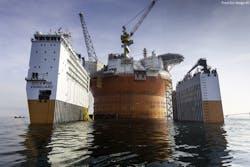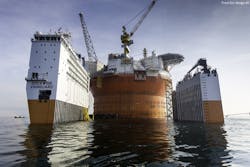Oil flows from Goliat platform in Norwegian Arctic
Eni SPA has started production from its Goliat platform in production license 229 in an ice-free area of the Barents Sea. The milestone follows numerous delays and cost overruns.
Boasted by Eni as the world’s northernmost producing offshore oil field, Goliat was developed with a cylindrical floating production, storage, and offloading vessel built to withstand the harsh conditions of the Arctic. It has a capacity of 1 million bbl of oil.
The FPSO was floated off Hammerfest last April, and, after final preparations, was towed 85 km northwest to its current location (OGJ Online, Apr. 28, 2015).
Output is slated to reach 100,000 b/d, of which 65,000 boe/d is net to Eni. The field is estimated to hold 180 million bbl in oil reserves.
Production will take place through a subsea system consisting of 22 wells, of which 17 are already completed. Of the total, 12 are slated to be oil producers, 7 water injectors, and 3 gas injectors.
Goliat receives power from shore through subsea cables, reducing carbon dioxide emissions by 50% compared with alternative solutions, while water and gas products are reinjected into the reservoir, the firm says.
Eni holds 65% interest as operator in PL 229. Statoil ASA holds the remaining 35%.
Eni has been present in Norway since 1965, operating through subsidiary Eni Norge AS. The firm has interests in exploration licenses and production fields, including Ekofisk, Asgard, Heidrun, and Kristin, with total equity production in 2015 of 106,000 boe/d.

